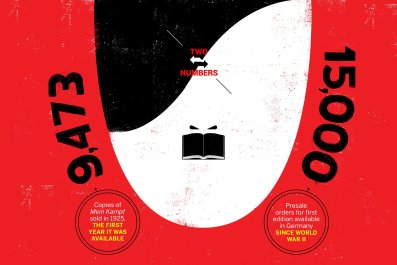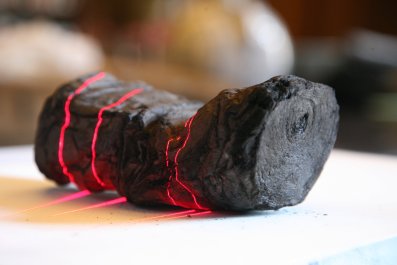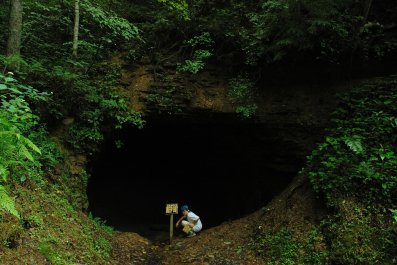With her white lab coat and big strawberry blond hair, Linda Pilkington looks rather like a very glamorous hospital doctor. But Pilkington's way of making people feel an awful lot better is not by healing their bodies but by creating remarkable, mood-improving perfumes. She has just one small boutique, Ormonde Jayne, in London, where half her business is in bespoke fragrances. That is how I got to know her about 10 years ago, when I wandered in looking for a scented candle for Christmas. The fragrance I wanted was in the air already, an ecclesiastical and spicy exercise in olfactory opulence, but the conveyance I wanted was not. At least not for another 48 hours, by which time she had created a pail-sized candle with three wicks. It was a sweet-smelling Christmas.
Since then, I have been a regular visitor to her lacquered jewel box of a shop in Royal Arcade, just off London's Old Bond Street. The combination of smoked-glass mirrors, black walls, subtle gilt metal and orange packaging is what Diana Vreeland and Halston might have come up with had they designed an opium den together.
Fragrances are about as close to abstraction as it is possible for a physical item to be—a series of molecules bound together to interact with the olfactory nerve, evoking something in the brain that is even less concrete than an idea or a thought. It is a sort of sorcery.
Of course, I'm only talking about the good stuff.
No offense to Britney Spears's body mist, the Lynx Effect or even some of the high-end brands that go in for what the marketers call "masstige" fragrances (that's "prestige for the masses"), but it is hard to make an original fragrance that has global appeal. The sense of smell is so personal that it's easier for commercial purposes if the fragrance does not smell too idiosyncratic.
By contrast, Ormonde Jayne fragrances smell of many things. For Pilkington, creating a fragrance is like taking a journey packed with experiences. Hers are so exotic and so powerful that it is odd to think they are made in a laboratory near London's Regent's Park. Going into her shop when she is in residence and being sprayed with clouds of newly devised cocktails to be inhaled rather than imbibed is to take a small holiday. It reminds me of the passage in Joris-Karl Huysmans's A Rebours when the protagonist decides to re-create the smells and sensations of travel without leaving his house. Pilkington always seems to have returned from a field trip to some impossibly far-flung plantation, orchard, arboretum or garden to bring back a precious essence.
Most recently, her obsession has been oudh. Also known as oud or agarwood, oudh is a woody aromatic scent long associated with the Middle East and Southeast Asia. But on Pilkington's travels in Thailand, she heard about oudh traders in Nana, the predominantly Arab quarter of Bangkok.
She manages to make the trip sound like a cross between Raiders of the Lost Ark and A Thousand and One Arabian Nights. "It was quite amazing, turning from the hubbub of a typical Asian metropolis into a road where almost every person, store and restaurant was Middle Eastern," she says. "Huge limousines with bodyguards parked outside shops. Inside, the dealers were showing the quality of their oudh in various forms and bartering with buyers from the Gulf over shipments worth many thousands of dollars. The expensive oils were all kept under lock and key in the safe, dried agarwood [the source of oudh] was locked in glass displays, and lower grades of oudh oil made into agarbattis [incense sticks] were piled all around."
Much as I like the tale Pilkington tells of oudh, my favorite of all her scents remains Orris Noir: When I am complimented on a fragrance, it tends to be Orris Noir that I am wearing. Like many of her signature fragrances, it is named after its key ingredient: the purple-black iris flower.
Another, Champaca, happens to be a small orange wildflower from India. Sampaquita, a species of jasmine, is the national flower of the Philippines. Ta'if, inspired by an Arabian rose, is cultivated in the Saudi city of the same name at an altitude of more than 6,000 feet. Tolu takes its name from the resin harvested from a South American tree. And then in an inspired touch, these oils are blended with geographically compatible ingredients. Champaca's evocation of the subcontinent is enhanced with notes of green tea and basmati rice. So the dates and orange blossom you might be able to detect in Ta'if refer to the things that rose growers in that part of the world like to eat.
You would not, however, want to ingest the ingredients of Ormonde Man, one of which is hemlock. Having smelled and enjoyed Ormonde Man, I am happy to take it on trust that the poison that Socrates was forced to drink after being sentenced to death by a jury of his fellow Athenians smells a lot better than it tastes.





















